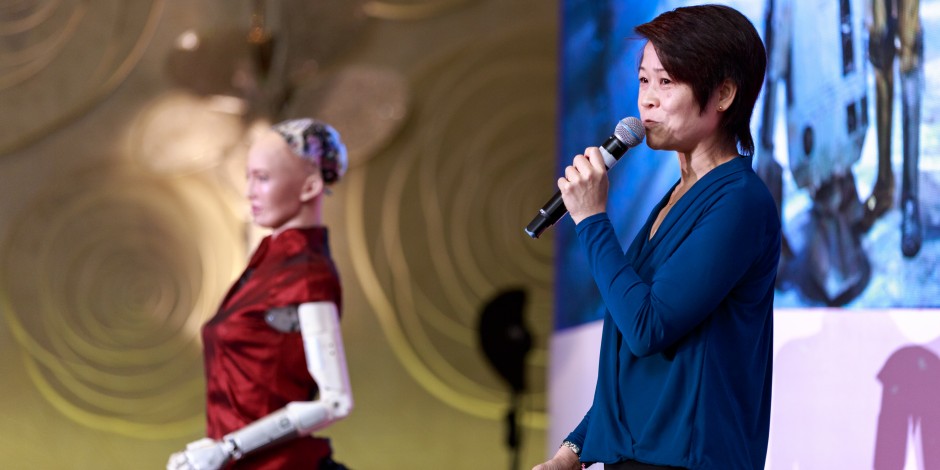Originally published by The Drum on June 14, 2019, written by Charlotte McEleny

Hanson Robotics is the creator of Sophia, a social humanoid robot that also happens to be the first United Nations Development Programme Innovation Champion. Hanson Robotic’s chief executive officer Jeanne Lim, an ex-marketer at brands including Dell and Cisco, has helped Sophia become one of robotics most famous faces.
Speaking at Mediacom’s Blink event in Singapore last month, Lim discussed the history of Sophia, as well as artificial intelligence (AI) and how it can increase brand recognition and is omnipresent as brands can divide between channels and devices, drive consumer experience and collect data better.
In a conversation with The Drum at the event, Lim explains that the company is continuing to develop Sophie’s technology and talents and that the work will be funneled into service robot development.
“Sophia as a character has multiple talents and right now we’re working on her conversational talents. We are testing her facial recognition and perception talents. We’re actually teaching her how to do finger drawing and teaching her to play the piano,” she says.
“We have a talent road map, and then we want to develop her multiple talents. The other thing is around Sophia as a technology platform, which is going to inspire a new line of service robots. We’re designing that service robot right now. It would be more people-friendly, more capable of mobility, and the service robot would be able to be deployed in volume. For example, in shops, shopping malls, and so forth.”
Our one-on-one with @RealSophiaRobot. She thinks @katyperry is the most interesting person she follows on social media! @MediaComGlobal @hansonrobotics @TheDrum #BlinkLive pic.twitter.com/bIv7mTm5Qi
— TheDrumAPAC (@TheDrumAPAC) May 31, 2019
A key part of the research around Sophia is to understand how humans react to robots, particularly with a humanoid face. Under Lim’s lead, first as chief marketing officer and now as chief executive officer, Hanson Robotics has secured a lot of press for Sophia, including the involvement with the UN Development Programme.
“The purpose of that is basically to inspire people that technology can be an enabler and a solution to a lot of problems. These problems include access to education, human rights, equality and also sustainable development because technology nowadays is so much better than humans in finding out the optimum solution. A lot of the problems need very complicated solutions, it’s not just one solution this way but a combination of very many different solutions and how do you actually optimize it in the best possible way. This is her role to promote technology to solve some of these problems,” she explains.
This positive press and the involvement of Hanson Robotics in pushing forward technology for good is helping soften the reactions to Sophia, according to Lim. As Sophia is designed to mimic a human, so the uncanny valley effect, which describes a close resemblance to humans that generates unease, has been evident. However, Lim says this is improving, the more Sophia is in the press.
“I’ve seen a change over the past three and a half years, after being with the company. Initially, probably 50% of the people who come up to her are a little bit afraid,” she explains.
“Nowadays, it’s very settling, maybe one out of twenty people are a little bit afraid. I think one reason is, because of the technology advancement, people are getting used to this kind of robot design. And the other thing is, because she’s been in the media a lot, it’s almost like she, people know her. So, it’s sort of like when you first encounter a culture that you don’t know about, you’re not sure whether they share your values, they look very different. You’re a little bit afraid.”
She adds: “But then, if you make friends with them, hang out with them, know their family, then there’s no fear. They’re part of you. So, I think this is going to be where robots will be when they move in, work among us.”
The uncanny valley is one fear that is driven by technology, but there is also a broader fear of AI that is present in a lot of discussions. For Lim, the fear of AI is all in the unknown and because most companies that are leading in AI are doing so with a very closed black box approach.
“People do fear technology because it’s unknown. Especially when you talk about AI because it’s like a black box for most people. You can’t know what is the algorithm, you don’t know. You have input and then you have some output. So, actually, what people fear is the black box because it’s not transparent. We’re used to knowing everything. We pride ourselves on knowing everything that’s happening and it’s okay for us. It is transparent. But if it’s a black box, we get very uncomfortable,” she explains.
Another element, according to Lim, is the impact on the job market. Lim is bullish that, while it is fair to be concerned, it is about not jobs replacement but job skills replacement. She argues that those who adapt will be able to fill the new, changing roles that are required.
Blending human emotional reactions with the efficiency of robotics and AI is an important topic for the industry, and as an ex-marketer, Lim argues that brands are actually veering too far towards non-emotional, longer-term marketing for shorter-term optimization type strategies.
“I would consider me an old school marketer. In the past, it’s all about the big brand campaigns. In a way, we’re very advanced now, I can never keep up with the latest marketing technology,” she explains.
“But we’re also very analytics-based, which is great, but sometimes I do feel that there is an opportunity to go back to the emotional connection with the customer, and not just transactional. Because a lot of times marketers now push to generate leads and then it becomes transactional.”
She continues: “How many leads did you get today and tomorrow? In the past it’s all about creating a perception, managing the perception, creating a desire, and fulfilling a desire. So, it’s emotional. And then, once you create that, then the demand will come. It’s more a demand creation, rather than a demand fulfillment or regeneration.”
This ethos is also part of how she believes society can eradicate the fear of robots; the more human connections made by physically being around robots, the better for its development and the quicker it eases the fear.
Photo and video credits: The Drum





Recent Comments